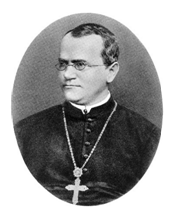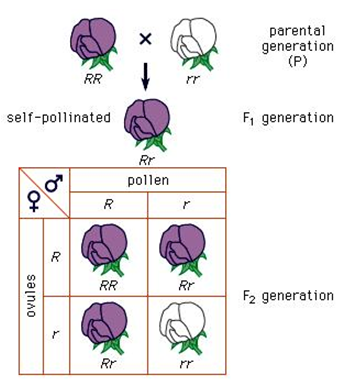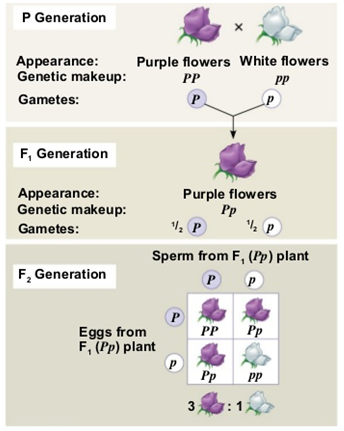Mendel and the Gene Idea
 The Deck of Genes
The Deck of Genes
If you saw a woman with bright purple hair walking down the street, you would probably infer that she had not inherited her striking hair color from either of the parent. Consciously or not, you have transformed the observation of hair color into a list of possible variations that occur naturally among people. Brown, blue, gray or green eyes; black, brown, red or blond hair- these are just a few examples of heritable variations that can be observed among individuals of a population.
 What are the genetic principles that account for the transmission of such traits from parents to offspring in humans and other organisms?
The explanation of heredity in 1800s was the ‘blending’ hypothesis. This hypothesis states that the genetic material contributed by the two parents’ mixes in a manner similar to the way blue and yellow paints blends to make green. This hypothesis predicts that a freely mating population gives rise to a unique combination of individuals.
An alternative to blending model is “particulate†hypothesis of inheritance: the gene idea. The “particulate†here refers to the genes. So according to this model, parents pass on these genes that retain their separate identities in the offspring. The collection of gene in an organism is more like a deck of cards. Like cards, genes can be shuffled and passed along, generation after generation.
Modern genetics had its origin in an abbey garden, where a monk named Gregor Mendel documented mechanism of inheritance. Mendel developed his theory of inheritance several decades before chromosomes were observed under the microscope and their significance was understood. Here we will step into Mendel’s garden to re-create his experiments and explain how he deduced his theory of inheritance.
Mendel’s Experimental, Quantitative Approach
Mendel discovered the basic principles of inheritance by breeding garden in carefully planned experiments. Around 1857, Mendel began breeding garden peas in the abbey garden to study inheritance.
Why Mendel chose to work with peas?
- They are available in many varieties. For example, one variety has purple flowers, while another variety has white flowers.
2.
- A heritable feature that varies among individuals, such as flower color, is called a character.
- Each variant for a character, such as purple or white color for flowers, is called a trait.
Peas have short generation time.
- Large number of offspring can be obtained from a single mating.
- By using pea plants, Mendel could strictly control mating between the plants. Each pea flower has both a pollen-producing organ (stamens) and egg-bearing organ (carpels). Mendel removed the immature stamens (emasculation) of a plant before they produced pollen and then dusted pollen from another plant onto the altered flower. Each resulting zygote then developed into a plant embryo encased in a seed (pea).
Mendel tracked only those characters that occurred in two alternative forms. For example, his plants had either purple flowers or white flowers, there were no colors intermediate between these two varieties. If he had focused on characters that varies continuously among individuals, seed weight for example, he would not have discovered the genetic nature of inheritance.
Mendel made sure that he used only those varieties which over many generations of self-pollination produced the same variety as the parent plant.Such plants are said to be true breeding. For example, a plant with purple flowers is true breeding if the seeds produced by self-pollination gives rise to the plants having purple flowers only.
In a typical breeding experiment, Mendel cross-pollinated two true breeding peas varieties- for example, purple-flowered plants and white-flowered plants. This mating or crossing of two true breeding varieties is known as hybridization.The true breeding parents are referred to as the P generation(parental generation), and their hybrid offspring are the F1 generation(first filial generation). When these F1 hybrids are allowed to self-pollinate, they produce F2 generation(second filial generation). Mendel followed traits for P1, F1 and F2 generation.
Law of Segregation
The F1 hybrids from a cross between purple flowered and white flowered pea plants are all purple flowered pea plants. What happened to the white flowered plants’ genetic contribution to the hybrids? If it were lost, then the F1 plants could produce purple flowered offspring in the F2 generation. But when Mendel allowed the F1 plants to self-pollinate and planted their seeds, the white flower trait reappeared in the F2 generation.
Mendel reasoned that the heritable factor for the white flowers did not disappear in the F1 plants, but was somehow hidden, or masked, when the purple flower factor was present. In Mendel’s terminology, purple flower color is a dominant trait, white flower color is a recessive trait. The reappearance of white flowered plants in the F2 generation was evidence that the heritable factor causing white flowers had not been diluted or destroyed by coexisting with the purple flower factor in the F1 hybrids.
Mendel’s Model
Mendel developed a model to explain the 3:1 ratio inheritance pattern that he consistently observed among the F2 offspring in his pea experiments. Four related concepts making up this model are:
- Alternative forms of genes account for variations in inherited characters. For example, the gene for flower color, exists in two versions, one purple flowers and the other for white flowers. The alternative forms of gene are called alleles.
- For each character, an organism inherits two copies of a gene, one from each parent. The two alleles on a particular location on the chromosome may be identical, as in the true breeding plants of Mendel’s P generation. Or the alleles may be differing, as in F1 hybrids.
- If the two alleles at a locus differ, then one, the dominant allele, determines the organism’s appearance; the other, the recessive allele, has no noticeable effect on the organism’s appearance. Mendel’s F1 plants had purple flowers because the allele for that trait is dominant and allele for recessive trait is recessive.
- Law of Segregation – The two alleles of a heritable character segregate (separate from each other) during gamete formation and end up in different gamete. Thus an egg or a sperm gets one of the two alleles. In terms of chromosomes, this segregation corresponds to the distribution of the two members of a pair of homologous chromosomes to different gametes in meiosis.
Does Mendel’s segregation model account for the 3:1 ratio he observed in the F2 generation of his numerous crosses?
This figure illustrates the combinations using a Punnett square,a diagrammatic device for predicting the allele composition of offspring from a cross between individuals which are genetically similar. We use a capital letter to symbolize a dominant allele and a lowercase letter for a recessive allele.
P– purple flower allele
p- white flower allele
In the F2 offspring, what color will the flowers be?
One-fourth of the plants have inherited two purple flower alleles; these plants will have purple flowers. One-half of the plants have inherited one purple flower
allele and one white flower allele; these plants will also have the purple flowers, the dominant trait. Finally, one-fourth of the F2 plants have inherited two white flower alleles and will express the recessive trait. Thus, Mendel’s model account for the 3:1 ratio of trait that he observed in the F2 generation.
The Law of Independent Assortment
Mendel derived the law of segregation in which he followed a single character that is flower color.All the F1 progeny produced in his crosses of true-breeding
parents were monohybrids,meaning that they were heterozygous for the one particular character being followed in the cross. We refer to a cross between such heterozygotes as a monohybrid cross.
Mendel identified his second law of inheritance by following two characters at the same time, such as seed color and seed shape. Seeds (peas) may be either yellow or green. They also may be either round (smooth) or wrinkled. From single character crosses, Mendel knew that the allele for yellow seeds is dominant (Y), and the allele for green seeds is recessive (y). For the seed-shape character, the allele for round is dominant (R), and the allele for wrinkled is recessive (r).
Imagine crossing two true-breeding pea varieties that differ in both of these charactersâ€â€a cross between a plant with yellow round seeds (YYRR) and a plant with green-wrinkled seeds (yyrr). The F1 plants will be dihybrids, individuals heterozygous for the two characters being followed in the cross (YyRr).
But are these two characters transmitted from parents to offspring as a package? That is, will the Y and R alleles always stay together, generation after generation? Or are seed color and seed shape inherited independently?
The F1 plants, of genotype YyRr, exhibit both dominant phenotypes, yellow seeds with round shapes, no matter which hypothesis is correct. The key step in the experiment is to see what happens when F1 plants self-pollinate and produce F2 offspring. If the hybrids must transmit their alleles in the same combinations in which the alleles were inherited from the P generation, then the F1 hybrids will produce only two classes of gametes: YR and yr. This “dependent assortment†hypothesis predicts that the phenotypic ratio of the F2 generation will be 3:1, just as in a monohybrid cross.
The alternative hypothesis is that the two pairs of alleles segregate independently of each other. In other words, genes are packaged into gametes in all possible allelic combinations, as long as each gamete has one allele for each gene. In our example, an F1 plant will produce four classes of gametes in equal quantities: YR, Yr, yR, and yr. If sperm of the four classes fertilize eggs of the four classes, there will be 16 (4X4) equally probable ways in which the alleles can combine in the F2 generation, a right side. These combinations result in four phenotypic categories with a ratio of 9:3:3:1 (nine yellow-round to three green-round to three yellow-wrinkled to one green wrinkled). When Mendel did the experiment and classified the F2 offspring, his results were close to the predicted 9:3:3:1 phenotypic ratio, supporting the hypothesis that the alleles for one gene controlling seed color or seed shape, in this exampleâ€â€are sorted into gametes independently of the alleles of other genes.
Mendel tested his seven pea characters in various dihybrid combinations and always observed a 9:3:3:1 phenotypic ratio in the F2 generation. The results of Mendel’s dihybrid experiments are the basis for what we now call the law of independent assortment, which states that each pair of alleles segregates independently of each other pair of alleles during gamete formation.
This law applies only to genes (allele pairs) located on different chromosomesâ€â€that is, on chromosomes that are not homologousâ€â€or very far apart on the same chromosome. All the pea characters Mendel chose for analysis were controlled by genes on different chromosomes (or far apart on one chromosome); this situation greatly simplified interpretation of his multi character pea crosses.
Mendel tested his seven pea characters in various dihybrid combinations and always observed a 9:3:3:1 phenotypic ratio in the F2 generation. The results of Mendel’s dihybrid experiments are the basis for what we now call the law of independent assortment, which states that each pair of alleles segregates independently of each other pair of alleles during gamete formation.
This law applies only to genes (allele pairs) located on different chromosomesâ€â€that is, on chromosomes that are not homologousâ€â€or very far apart on the same chromosome. All the pea characters Mendel chose for analysis were controlled by genes on different chromosomes (or far apart on one chromosome); this situation greatly simplified interpretation of his multi character pea crosses.


